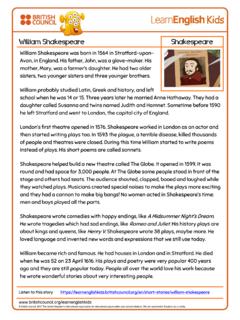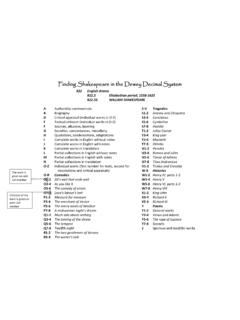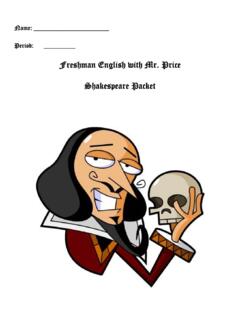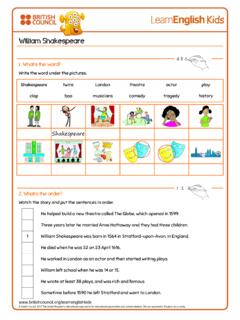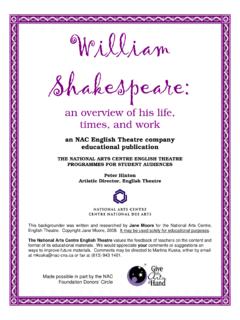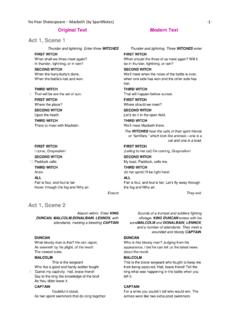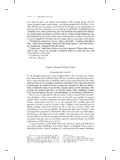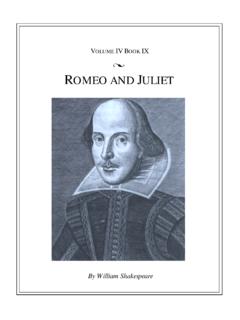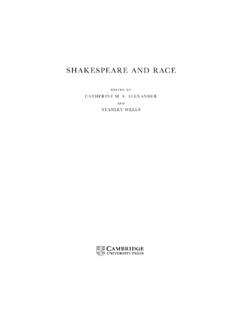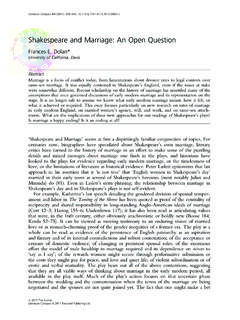Transcription of William ShakeSpeare’S JULIUS
1 Presented by Shakespearience a program of the Idaho shakespeare Festival A Study Guide for By William shakespeare Directed by Sara Bruner Assistant Director: Jaclyn Miller Sound Design: Matthew Webb Set Design: Will Ledbetter Scenic Painter: Angi Grow Costume Design: Lucy Wells Costume Assistant: Chantell Fuller Special thanks to: BSU Theater Department Costume Shop JULIUS CAESAR Beware the Ides of March William shakespeare S 2 3 Section four: APPENDIX Special 4 Using this study 4 About the Idaho shakespeare 5 A note from the 5 Meet the 6 About William 7 Interesting William shakespeare 8 An Introduction to JULIUS 9 Who was JULIUS 10 JULIUS Caesar Play by 11-12 JULIUS Caesar: Character 13 Activity: Will s 14 Activity: Word 15 Activity: The 15-Minute 16-19 Activity: Breaking News!..pg 20 Activity: Character 21 Activity: Shakespearean 22 Activity: 23-25 Activity: Sound 26 Activity: Gender in 27 Exploring JULIUS 28 Activity: Art of the 29 Activity: # 30 Activity: Think Like a 31 Theme to follow: Trust your 31 Theme to follow: Regret.
2 Pg 31 32 Suggested 32 End 33 Festival 34 Section two: BEFORE THE SHOW Section one: WELCOME! table of contents Section three: AFTER THE SHOW 4 Dear Teachers, Welcome to the Shakespearience study guide for JULIUS Caesar. These materials have been designed to expand your students en-gagement with the performance as well as provide back ground knowledge on William shakespeare and the influential literature he wrote. This resource includes a range of information, discussion topics, and activities that can stand on their own or serve as building blocks for a larger unit. The activities are designed to be mixed, matched and modified to suit the needs of your particular students. Inside, you ll find activities to share with your students both before the show and after the show, indicated by headings at the top of the page. These are designed to help focus your students engagement with the performance by giving them specific themes to watch out for, as well as topics for discussion following the performance.
3 Each activity is designed to meet Idaho Standards of Education to foster critical thinking and problem solving skills. We encourage you and your students to share your thoughts with us! Any of the artwork or activities your students send will be shared with the artists who created JULIUS Caesar, and any feedback from you will help to improve our study guides for future audiences! Our mailing address is located on page 31. Thank you so much! Using This welcome! A Very Special Thank You! As a part of Idaho shakespeare Festival s educational programming, Shakespearience performances have enriched the lives of well over one million students and teachers since 1981 with productions that convey the unique and impactful voice of theater arts. The magic of this art form is brought to schools across the State of Idaho each Winter/Spring semester with assistance from a generous group of underwriters: Arts Midwest National Endowment for the Arts shakespeare in American Communities Idaho Commission on the Arts Idaho Humanities Council and National Endowment for the Humanities Laura Moore Cunningham Foundation Idaho Community Foundation and the following funds: o , Anne G.
4 & Beverly B. Bistline Philanthropic Fund o James A. Pinney Memorial Fund o Perc H. Shelton & Gladys A. Pospisil Shelton Foundation o Gladys E. Langroise Advised Fund Wells Fargo Idaho Power Foundation John William Jackson Fund The Whittenberger Foundation 5 About our education The Idaho shakespeare Festival has become an integral part of the arts education throughout Idaho. The Festival s annual Shakespearience tour brings live theater to more than 25,000 high-school students in more than 70 Idaho communities each year. Since it began touring in 1986, Shakespearience has enriched the lives of nearly 500,000 students. In 1999, the Festival assumed the operations of Idaho Theater for Youth (ITY). This alliance has more than doubled the Festival s annual educational programming, resulting in the Festival becoming the largest provider of professional, performing arts outreach in the state of Idaho.
5 In addition to the statewide Idaho Theater for Youth school tour, which brings professional productions to nearly 30,000 students in grades K-6 across Idaho, the Festival oversees year-round School of Theater programs. This series of classes in acting, playwriting and production, for students of all ages, enrolls over 300 Treasure Valley students each year. Look for upcoming student productions throughout the summer, fall and spring. For more information on any of the Festival s educational activities, please contact the Education Department at the Idaho shakespeare Festival offices or by email at A Note From the We are very proud to present our adapta-tion of JULIUS Caesar to you. The play first premi-ered in 1599, and like most of shakespeare s work, has aged beautifully and still holds in-credible merit as a piece of literature and dra-ma. When this play was first presented, it was performed by a company of all white men (as was the custom and law of the time) in England- a country that was governed by Queen Eliza-beth.
6 With that in mind- how is this play differ-ent, or the same, in America in 2018 when it is told by a group of diverse actors? How, if at all, is the play different with certain roles being por-trayed by women? We encourage you to think about power, the cycle of violence, leadership, intuition, action, and consequence while watch-ing the play. The aim of this production is not only to entertain and to build a bridge between this classic work and our contemporary world; but to invite questions that spark meaningful discourse. - Sara Bruner, director before the show 6 meet the artists! The Cast of JULIUS Caesar before the show Patrick John Kiernan Jonathan Bangs Evan Stevens Lakia Solomon Nate John Mark Jaime Nebeker 7 before the show William shakespeare was born in April 1564 in the town of Stratford-upon-Avon, on England s Avon River. Because of poor record-keeping in small towns, his exact day of birth is unknown; it is traditionally celebrated on April 23rd.
7 When he was eighteen, he married Anne Hathaway (who was 26 at the time). The couple had three children, one of whom died of the plague in childhood. The bulk of shakespeare s working life was spent in London. He enjoyed success not only as a playwright, but also as an actor and shareholder in the acting company, Lord Chamberlain s Men (later known as the King s Men). In 1593 shakespeare became a published poet; at the time theaters had been closed due to the plague, a contagious epidemic disease that devastated the population of London. He wrote many of his plays on English history as well as several comedies and at least two tragedies (Titus Andronicus and Romeo and Juliet). It is assumed that Shake-speare s sonnets were also written during the 1590s. When the theaters reopened in 1594, shakespeare continued his career as an actor, playwright, and acting company shareholder.
8 His career would span over the next twenty years. In 1599, Lord Chamberlain s Men built a theater for themselves across the river from London, naming it The Globe. The plays that are considered by many to be shakespeare s major tragedies (Hamlet, Othello, King Lear, and Macbeth) were written while the company was residing in this theater, as were such comedies as Twelfth Night and Measure for Measure. Many of shakespeare s plays were performed at court (both for Queen Elizabeth I and her successor King James I), some were presented at the Inns of Court (the residencies of London s legal societies), and some were doubtless performed in other towns, at the universities, and at great houses when the acting company went on tour. The Life and Times of William shakespeare Between 1608 and 1612, shakespeare wrote several plays among them The Winter s Tale and The Tempest presumably for the company s new indoor Blackfriars theater, though the plays seem to have been performed at the Globe and at court as well.
9 shakespeare wrote very little after 1612, widely thought to be the year he wrote King Henry VIII. It was during a perfor-mance of Henry VIII in 1613 that the Globe theater caught fire and burned to the ground. shakespeare retired from the stage sometime between 1610 and 1613 and returned to Stratford, where he died on April 23rd, 1616. Until the 18th Century, shakespeare was generally thought to have been no more than a simple, rough and untutored genius. Theories were advanced that his plays had actually been written by someone more educated, perhaps statesman and philosopher Sir Francis Bacon or the Earl of Southampton, who was shakespeare s primary patron. However, he was celebrated in his own time by English writer Ben Johnson and others who saw in him a brilliance that would endure. Since the 19th century, shakespeare s achievements have been more consistently recognized, and throughout the Western world he has come to be regarded as the greatest dramatist ever.
10 Though there is certainly a standard depiction of his appearance, no portrait of shakespeare was ever produced while he was alive; this mysterious fact adds to the theory that shakespeare may have not been the artist behind his plays. 8 shakespeare was also an actor who performed many of his own plays as well as those of other playwrights. There is evidence that he played the ghost in Hamlet and a servant named Adam in As You Like It. did you know? If you were to Google shakespeare , you would receive over 15 million pages of results! Elizabethan theatergoers, such as those in William shakespeare 's time, could purchase apples and pears to eat during the show. These snacks were often thrown at the actors by dissatisfied members of the audience shakespeare is the second most quoted author in the English language. The only other text quoted more frequently than shakespeare s works is the Bible.
